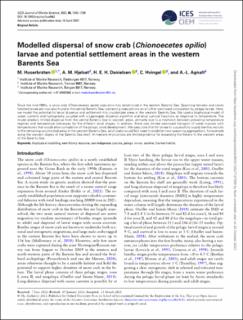Modelled dispersal of snow crab (Chionoecetes opilio) larvae and potential settlement areas in the western Barents Sea
Huserbråten, Mats Brockstedt Olsen; Hjelset, Ann Merete; Danielsen, Hanna Ellerine Helle; Hvingel, Carsten; Agnalt, Ann-Lisbeth
Peer reviewed, Journal article
Published version
Permanent lenke
https://hdl.handle.net/11250/3098132Utgivelsesdato
2023Metadata
Vis full innførselSamlinger
- Articles [3012]
- Publikasjoner fra CRIStin [3070]
Sammendrag
Since the mid-1990s, a snow crab (Chionoecetes opilio) population has established in the eastern Barents Sea. Spawning females and newly hatched larvae are now also found in the central Barents Sea, warranting speculations on a further westward colonization by pelagic larvae. Here, we model the potential for larval dispersal and settlement into uncolonized areas in the western Barents Sea. We used a biophysical model of ocean currents and hydrography, coupled with a Lagrangian dispersal algorithm and larval survival functions as response to temperature. The model predicts limited dispersal from the central Barents Sea to western areas, primarily due to a mismatch between prevailing temperature regimes and temperature tolerances for the different larval stages. In addition, there was limited westward transport of water masses with temperatures that would allow completion of the pelagic larval development. We speculate that for larvae to successfully supply benthic recruits to the remaining uncolonized areas in the western Barents Sea, adult crabs would first need to establish new spawning aggregations, for example along the western slopes of the Barents Sea shelf. Immediate implications are limited potential for expanding the fishery to the western areas of the Barents Sea.
